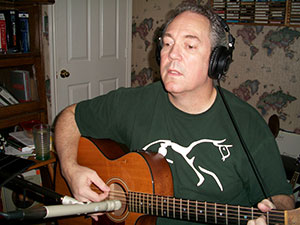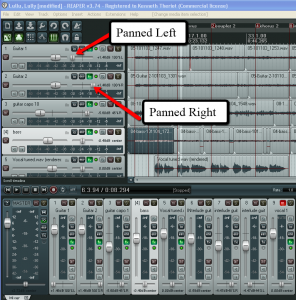 Recording acoustic guitar, along with some voices and other instruments, is one of the most common home recording activities out there. Today I thought I’d describe the techniques I use when recording this type of music. If you’d like to get an idea of how my recordings sound (pretty-much all acoustic/folk/singer-songwriter type music), you can hear a bunch of samples here: Ken Theriot’s Music.
Recording acoustic guitar, along with some voices and other instruments, is one of the most common home recording activities out there. Today I thought I’d describe the techniques I use when recording this type of music. If you’d like to get an idea of how my recordings sound (pretty-much all acoustic/folk/singer-songwriter type music), you can hear a bunch of samples here: Ken Theriot’s Music.
I recently finished recording a full CD of seasonal music, Ken and Lisa Theriot’s The Gifts of Midwinter, and I’ll be using one of the songs from that album as a sort of case-study for this article. Before we start, take a listen to the song here:
Audio Player
This song is close to “as basic as it gets.” It’s acoustic guitar, one voice singing, and a bass guitar. Here’s how I recorded it:
Recording Equipment
Let’s start with the microphones. For the guitar parts, I used a Shure SM-81, which is a thin pencil-style condenser microphone. The mic was plugged into my computer interface box, which in my case is an E-MU 1820m. It’s about 6 years old now. You can pick up a similar audio interface like that today starting at about $75. One example is the M-Audio M-Track, which you can get for just over $100. Plus it comes with Ableton Live Lite music creation software.
Anyway, that got the sound into my computer. To record the sound, I used my favorite recording and mixing software, Reaper, which you can pick up for $40 as long as it doesn’t make you more than $20,000 a year (honor system!).
For the voice I did the same thing as with the guitars, except there was a different microphone involved, the Rode NT2-A.
For the bass guitar, I used a “direct inject” box called the Line 6 Tone Direct similar to this one.
The Step-by-Step
First, I told Reaper to open a new project/song file and set the metronome to the correct tempo and time signature. I then turned on the click-track so everything I played would be synced to the same time.
Then as I listened to the click-track in my headphones, I played the guitar part onto the first track in Reaper. Next I started a 2nd track and played the same guitar part again. Then I panned the 1st track 100% to the right and the 2nd track 100% to the left. That gives the guitar a large stereo sound.
I opened a 3rd track and recorded one more guitar part. I put a capo on my guitar, transposed the chords, and played some different finger-style guitar in this higher register. I panned this guitar part about 20% to the right.
I then opened a 4th track and sang the vocal part, leaving it panned “dead-center” (panning – 0%).

Next I opened a 5th track and recorded a bass guitar part. I plugged the bass into the Line 6 box, told Reaper to bring sound in from the Line 6 device, and simply played along. I left the bass in the center of the stereo field (panned 0%) like the vocal.
I then listened to all the tracks together, altering the volume of each track so everything could be heard properly (this is the “mixing” part).
When it sounded good, I “rendered” or “mixed down” the project, resulting in a single stereo song file.
Finally, I opened the rendered song file in my audio editing program called “Adobe Audition.” I clipped off any extra space or noise from just before and just after the song, fading the end out smoothly. I made sure the overall volume as good, not too loud, not too soft, and saved it.
Finito. Have another listen to the finished product here: [jwplayer config=”Custom Audio Player-200″ mediaid=”15049″]
Please feel free to post any questions you may have about what I did to record this song in the comments section below.
Happy recording!
Ken
I was reading your guide about how to record to CD, and am lost. I am an old school piano player that has never caught up with technology. Ha! I play the piano for a small country church, and would like to record a whole service worth of songs that could easily be stopped and started by the song leader as the service progresses. If I could do this, perhaps I could take a Sunday off once in awhile, and not leave them to sing accapella. I am wanting to prepare this at home. I have a Yamaha electric piano and a Dell lap top computer. Can you talk me through it? Thanks.
Tony Holcomb
Saint Joseph, Missouri
Hi Tony,
There are several ways to do this. A lot depends on your budget and the type of piano you have. I would say the way to go would be to download a copy of Reaper (http://www.reaper.fm) and install it onto your laptop. Then I recommend you pick up an audio interface box such as the M-Audio Mobile Pre ($149.00), which has 2 inputs, and a pair of headphones. You’ll also need cables with 1/4 inch plugs. You’re piano probably has 2 output jacks in the back. Run one cable to one input on the interface and the other cable likewise. with the interface hooked up to your laptop via USB, open Reaper. See my Reaper tutorial here: http://youtu.be/vtEZ3yregsA. Record one song and save it as a project in Reaper. Now “render” (File/Render…) the project, which will create a wav file of the song on your computer. Then do that for every song you want to have on the CD. When you’ve finished that, you’ll have a collection of wav files, one for each song, that you can burn to a CDR (several programs can do this, including Windows Media Player). Just arrange the songs in the right order and that your song leader can understand, and you should be good to go!
I hope that helps. This was kind of an overview but for a comment reply…;).
Good luck!
Ken
ps- I like to use an audio editor (see here my article at: Best Audio Editor For Home Recording AFTER rendering the wav files to do things like ensure the volumes are loud enough and that each song is at a similar loudness to the other songs. With an editor you can do many other things as well to fine-tune the final versions (EQ, reverb, etc.).
I am one of those electronic/computer challenged special ed. guys. I clicked on the “M – Audio Fast Track” and the place that came up said it was no longer available. I would like to do something like your sample song with my granddaughter but don’t know how or where to get the necessary items. I already have the mikes but that is all. My guitar is acoustic. Any help would be most appreciated.
Regards,
David Pedersen
1219 Baldwin Street
Harlan, Iowa 51537
712-755-7470
gunrunner@harlannet.com
Hi David. I’m sorry about that, and thanks for letting me know. I have been replacing those links since the product went away, but apparently I’ve missed some. Currently, the replacement from M-Audio on that interface is the M-Audio M-Track for about the same price. I also have now replaced the link on that specific article. I hope that helps.
Happy New Year.
Ken
I have a casio piano my sister bought for me for about $60, a acoustic guitar without those things you plug in to make it louder, and a $200 asus labtop. I want to record these instrument and my voice. What do I need and how much will it cost? Thanks.
Kao – It’s fine that your guitar doesn’t have a pickup. They don’t typically sound very good when recording. You’ll want a mic for your guitar. This series of posts will got into detail to answer your question – https://www.homebrewaudio.com/how-to-build-a-home-recording-studio-part-1/ but basically, you can get decent results with the guitar and voice with a USB mic to get the most bang for your buck. Maybe start with something like the Samson q1u at a minimum (costs about $49). If/when your budget allows, you’ll get much better results with what I call “Recording Configuration 2,” which is an audio interface box (like the Focusrite Scarlett Solo to start), along with a large diaphragm condenser mic, like the Audio-Technica 2020 to start. From there, you can get even better results using a small-diaphragm condenser for the guitar (the large-diaphragm condenser for the voice and the small-diaphragm condenser for the guitar) like the Shure SM81. I can’t really say about the Casio keyboard. If it has a MIDI output, you might be able to use it for a controller for virtual instruments. For software, start with Audacity, which is free. But if/when you can afford the $60, get Reaper. That should give you options ranging from $49.99 all the way up to near a thousand dollars. Hope that helps. Read the article above for more details though.
I have a casio ctk-2080, an acoustic guitar, and an asus x551m.